


The style of photographic product emerging from the studios changed over the years, and is of use in helping to determine the period they were produced. This section of the site attempts to give an overview of these changes as an aid to dating them alongside the photographer's dates. The tables below illustrate some significant forms that are commonly seen. it has to be emphasised however, that there were some conservative practitioners with whom early forms lingered, and some others who devised their own unique styles. The dates tentatively given represent a 'core' period.
The first photographs commercially available in Glasgow were daguerreotypes, the first produced here in 1842. Because of their nature, they had to be protected behind glass. This also applies to a later technology, the ambrotype. A third early process produced ferrotypes ( or 'tintypes') which were cheaper. Some details of these are given in the table below.
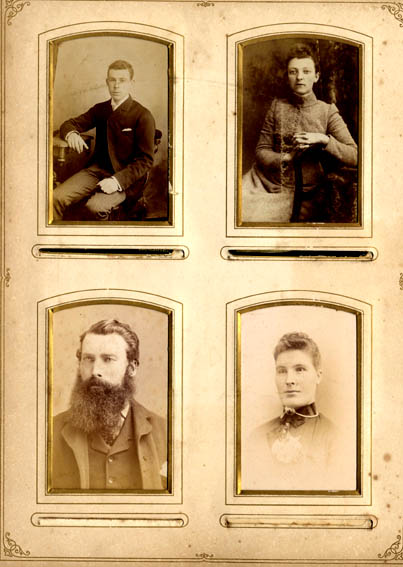
The most commonly encountered format for popular photographs from the 1860s was the carte de visite (cdv) which was a backing card 2½ inches by 4 inches, (6.3 x 10.3 mms), with a slightly smaller photographic positive pasted on. These were prints from a negative process, allowing many copies to be made. This format was patented in the late 1850s, and proved so popular that many millions were produced in the following years. Photographic albums were produced to accept this size, which served to reinforce the standard. The production of these cards reached a peak in the 1870s, but they continued to be made into Edwardian times.
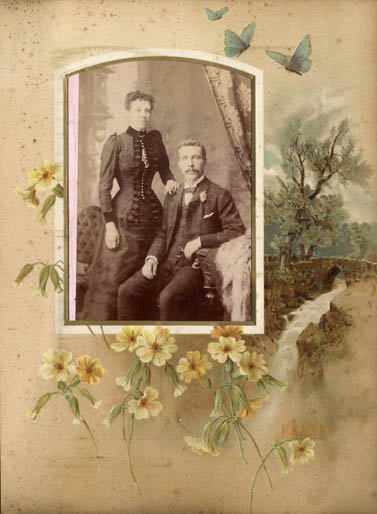
In the later 1860s the larger cabinet card was produced (4¼ inches by 6½, or 10.6 x 16.7cms) and albums were soon produced to contain both, which again served to maintain the standard sizes. Cabinet cards also continued into Edwardian times, by which time there were a variety of other formats arising out of the use of the then available personal cameras.
The type of photograph, and the design of the backing card are very useful in helping to narrow down a date. They evolved in a definite manner throughout the period, and they are illustrated along with the other types of photographic products in the table below.
| TYPE | DESCRIPTION | POSSIBLE DATES | DESIGN No. |
|---|---|---|---|
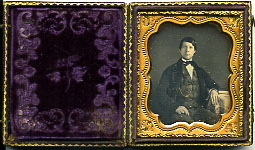 |
The first type of commercial images recorded in Glasgow were Daguerreotypes, produced first by a Mr. Treffry in 1842, soon followed by others. Because of the fragile nature of the surface, these had to be protected behind glass, and typically had a brass mount or frame, and the whole mounted in a cardboard or pseudo leather case. They can be recognisd by the mirror finish of the copper plate, giving a bright reflection, and by the weight, because of the copper. They were produced in small numbers over the following 25 years but were expensive, and could not easily be copied. A full plate was about 16.5 x 21.5cms, but half plate, and quarter, sixth and ninth plate sizes were more common. The image is reversed, so that rings appear to be on the wrong finger, and buttons are the wrong way round. | 1852 +- 10 | 0 |
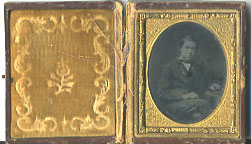 |
The ambrotype or colloidon positive was a later and cheaper technology, whereby a (photographically) thin glass negative was backed by a black surface, so that the light portions appeared dark, and vice versa. Again, the assembly had to be protected in a frame, often of the cheaper pinchbeck, and case mounted. The example shown from Dickson in St. Enoch square is about ninth plate size, the standard full 'plate' being 16.5 x 21.5 cms. The image is not as bright as the daguerreotype, and the unit is lighter in weight. Like the daguerreotype, the image may be reversed, depending on which way the glass negative is mounted. These were produced mainly in the late 1850s and early 1860s. | 1860 +- 5 | 0 |
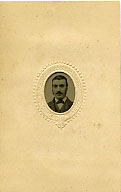 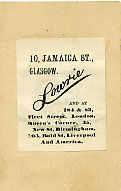 |
A third technology from the 1860s was the ferrotype, or tintype, which resulted in an image being produced on the surface of a thin metal plate. This was again cheaper than the daguerreotype, but suffered from the same problem that multiple copies could not be made. However when cdv cards became popular, and this shortcoming was a serious disadvantage, the solution which emerged was a camera which could take six, eight or even sixteen images on the one plate, which was then cut up and the small photos mounted in a cdv sized card. These 'gem tintypes' continued to be produced into the 1880s, as in this example. Though the image tended to be dull, the low cost meant that this process survived and continued to be used by itinerant photographers well into the twentieth century. | 1885 +- 30 | 0 |
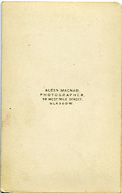 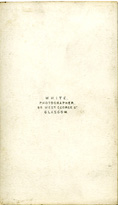 |
A French photographer, Disderi, patented in the late 1850s a small size of photocard, which became very popular in the continent, and then in Britain. Albums were made to contain these, which served to reinforce the standard, and soon millions were being produced. Possibly the earliest form of these 'cartes de visite' (cdvs) are those shown across. This early design of cdv had only the photographic print attached to the front of the card without any text.The text was confined to a small central area on the back, and gave only a name and address. Later a line appeared at the bottom of the back saying that 'Copies can be produced' or 'Duplicates can be provided'. | 1862 +- 2 | 2 |
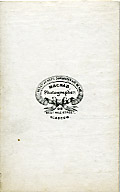 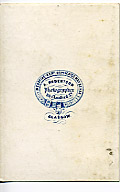 |
In this form, the name and address information was encapsulated in a small central graphic. There are a number of marginally different versions of this theme, and the differences suggest that just one may have 'inspired' the design of the others. | 1863 +- 2 | 6 |
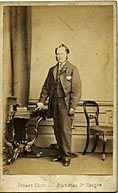 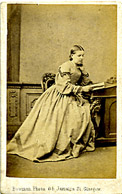 |
In this form the only text is below the image on the front, in a fine, black font. A number of these different forms could be in use by different photographers at any time, the one only gradually superseding the other. | 1864 +- 2 | 1 |
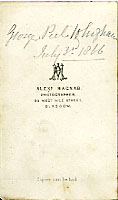 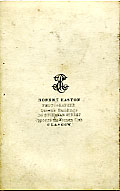 |
This form with the monogram above the text was another of the developments beyond the basic text only design. Cards onward from this period often carry a statement to the effect that 'Duplicates may be had' or ' Copies or enlargements can be produced' to show they are operating from a proper negative. | 1865 +- 2 | 6 |
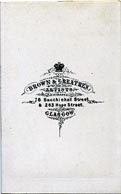 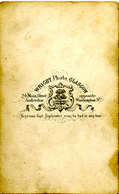 |
Here the plain text on the back has become embellished with some graphics, and some attempt has been made to create a pleasing design. The card is still thin and square cornered, without text on the front. | 1867 +- 3 | 9 |
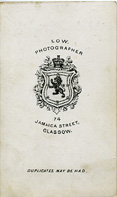 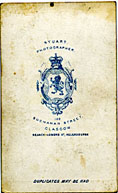 |
Again, this basic form appears in a number of marginally different versions, the differences suggesting that the one may just have 'inspired' the design the others. That being so, it is likely that they all appeared at much the same time. | 1864 +- 3 | 41 |
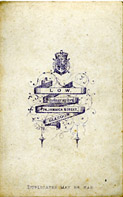 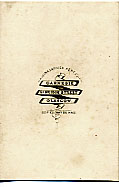 |
This design with the straight ribbon can also be dated to the mid 1860s. | 1866 +- 3 | 43 |
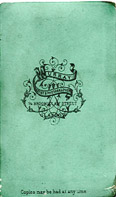 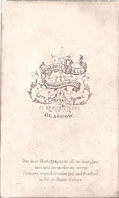 |
On these cards the ribbons are curved, which seems to have been a slightly later development, and dates to the late 1860s and early 1870s. | 1869 +- 3 | 47 |
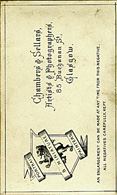 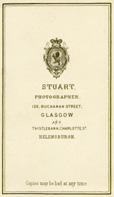 |
By the early 1870s the whole of the back of a cdv or by now cabinet card
can be given over to text and simple graphic elements. In these two examples the name of the photographer appears again
below the photographic print on the front. These cards are still square cornered, though others of the same
period have rounded corners, and are 0.018" to 0.24" thick. By this time the larger cabinet cards are beginning to appear (10.7 x 16.5cms) but their design seems to have been similar to the cdvs. |
1870 +- 3 | 14 |
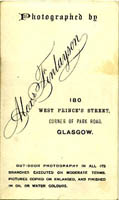 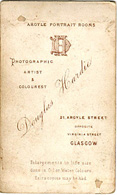 |
The feature of diagonal text in a large but light font seems to have appeared by the early 1870s and persisted into the late 1880s. Cards are generally round cornered and may contain more information about the facilities offered. | 1880 +- 8 | 18 |
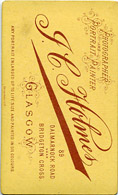 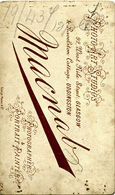 |
The diagonal text develops into a brasher and heavier form in the mid 1880s, and the edge of the card may be chamfered in addition to the gilding. | 1885 +- 3 | 20 |
 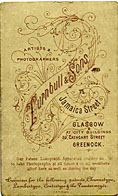 |
There was a period where an effusion of delicate spirals and filigree work decorated the backs of both cdvs and cabinet cards. The card is now thicker (0.032"), round cornered, and may have a gilt edge. Note on the first example here the remnants of the tissue which was glued to the top of the back to fold over the front for protection. This was common from the late 1870s for the following twenty years. | 1885+- 4 | 21 |
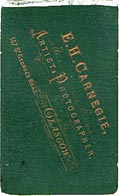 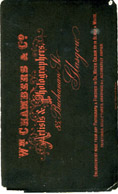 |
A major change in the early 1880s was the utilization of heavy dark coloured card (both sides) for cdvs and cabinet cards. Initially, as in these examples here, attempts were made to put the text on the back as before, but the dark colouration made it difficult to read. (these images have been tweaked to improve the legibility) There is no text on the front. This seems to have persisted for only a few years. till the mid 1880s. | 1885 +- 3 | 24 |
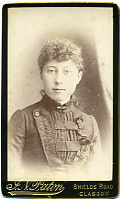 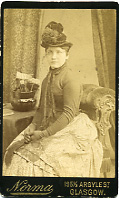 |
The next step was the production of perhaps the most commonly encountered type of cards - the 'green and gold' - a dark green card with gold lettering below the print on the front, and the back dark and blank. This form was used for both cdvs and cabinet cards. These are found from 1885 till the turn of the century, usually with gilt and chamfered edges. | 1892 +- 7 | 27 |
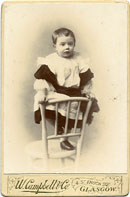 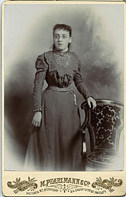 |
Fewer cdvs were produced after the 1880s and more cabinet cards are encountered. The remaining illustrations are all cabinet cards, ie, 10.6 x 16.7cms approx. In the mid 1990s these are found on a glossy light coloured card, with gold lettering below the image and artistic flourishes. This form appears to persist until the end of the century, but this and subsequent categories are provisional and tentative. | 1894 +- 7 | 30 |
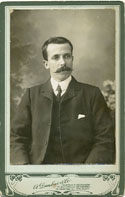 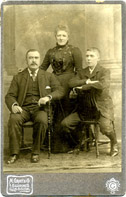 |
From the late 1890s till perhaps 1908 cabinet cards appeared that had a matt and toned surface, with various forms of text and decorative design below the image. | 1903 +- 5 | 34 |
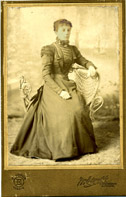 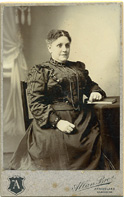 |
What is perhaps a subset of the above, but which appears regularly has a small logo at the lhs of the space under the photograph, with the name and address at the right. These cards are often square cornered. | 1903 +- 5 | 38 |
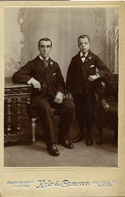 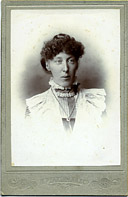 |
Another form of cabinet card has a textured or embossed surface. | 1903 +-6 | 35 |
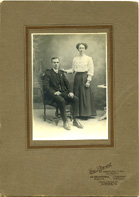 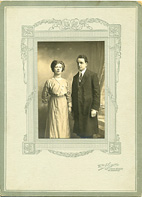 |
Into the new century, the forms of photographic product change, and the dimensions of the mounting card vary, though in many cases the print attached to it has the same dimensions as the print on the standard cabinet card. In both these examples the print is about 9.5 x 13.7cms, but in the first case the card is 17.7 x 25.1cms, and in the second, it is 21 x 27.6cms. | 1910 +- 5 | 0 |